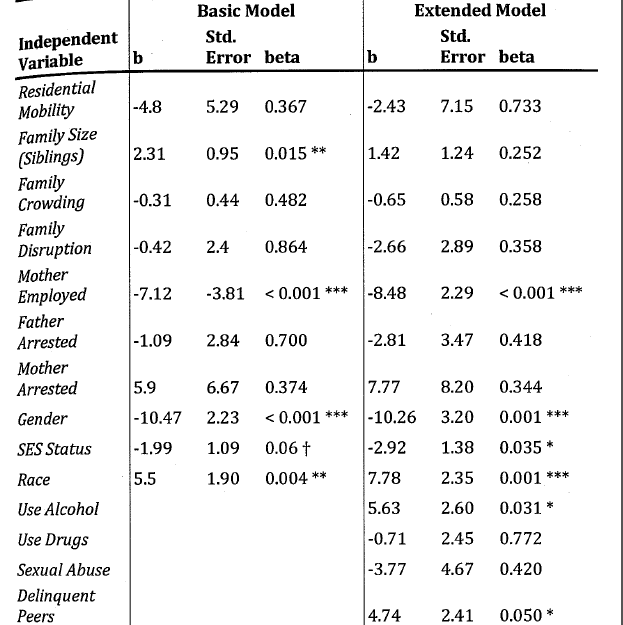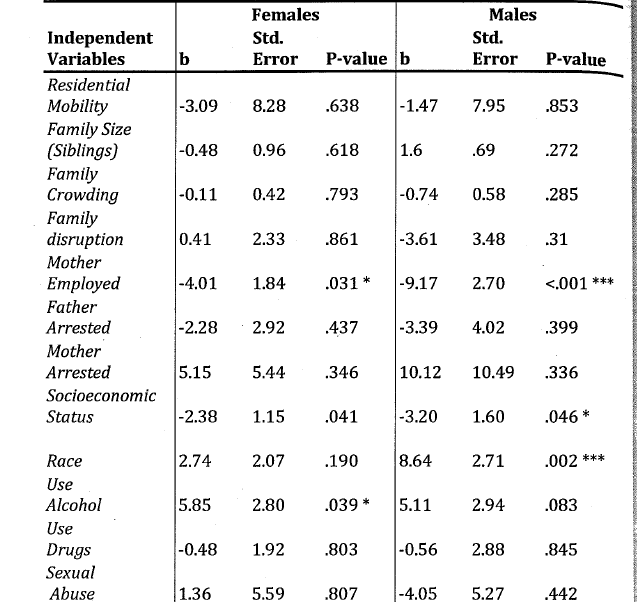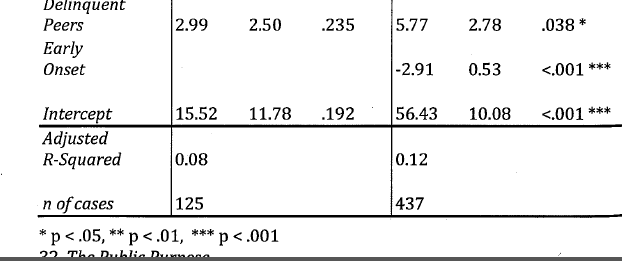Introduction
The life-course perspective shows that the patterns of crime vary as per individual life due to different attributing factors. Researchers have proved that both distant and persistent offending owe their history to this theory. Consequently, their behavior pattern normally results from some life-altering events in the course of their lives.
Juvenile patterns are linked majorly to the role of schools, family structure, peers group and siblings. At an adult stage, factors such as employment system, marriages, military works and residential areas give opportunities for explanation over adult crime patterns. Native Americans’ crime pattern has been traced to their family structure, positive female and male relationship, marginality, societal structure, employment system and poverty. This paper is focused a life course perspective that is sensitive to gender and age among the Native Americans.
The research follows both qualitative and quantitative measures to determine the theory among these groups. Life cause perspective gives unique opportunities for changes in social institutions to those of cultural and historical times based on the experience of individuals and families. Currently, challenges encountered in this perspective include refining and testing dynamics, the emergence of a fully conceptualize extending across paradigms of continuity and discontinuity knowledge (Sampson and Laub 45).
Life Course Theory
Life course perspective has three major paradigms, each slightly different from the other. The risk factor model focuses on the victims’ risk factors and vulnerabilities and prevention methods. The second approach is the development model, which centres on the offending development and its related risk factors. The third paradigm is the life perspective criminology with a focus on events in life, transitions and desistance methods from crime.
A number of offending statistics have been presented from the life course perspective in different communities. Among the Indian American, majority of juvenile offenders are of ages 8 to 14. Statistics also shows that criminal behaviours are constantly increasing in the community. High delinquencies indicate more crimes in adulthood, and among the Indians men is most crimes originate from drug abuse especially alcoholism. Drug abuse forms the root of criminal activities in most native minority groups.
The most highlighted crimes in courts and probation units include excess drinking, sexual related cases, recklessness driving, robberies and murders. Offenses committed vary with gender and age among the American races. Teenagers commit crimes under gang influence while adult Indians act alone (Sampson and Laub 45).
Studies have shown that there are differences in offending patterns based on age and gender. Native American women are mostly incarcerated over drug crimes such as alcohol and they normally victimise their close friends or relations but show little aggressiveness towards the use of weapons as compared to men (Bureau of Justice Statistics 45).
Most recorded offenses show that men commit crimes under the influences of drugs and to defend their status, while women offend for family financial requirements. Most women offenders report early childhood harassment and abuse as compared to men. Youth victims among Indians have shown consistency to come from family disruption, trauma from learning institutions and poverty (Clausen, 840).
Literature Review
Researchers have applied life course perspective in many areas across the world. In North America, the theory has been used in the investigation of several social aspects including house work among men (Coltrane and Ishii-Kuntz 51). Military and marriage times have also been determined through the approach (Call and Teachman 221).
Sampson and Laub applied it while investigating crime, delinquency and families’ structures (Sampson and Laub 211). Consequently, some researches based on substantive fields have been studied through this perspective method (Coltrane and Ishii-Kuntz 53).
In Canada, studies have been applied using the perspective over grandmotherhood transition (Akiko 117) and transition of youth into adulthood (Bengtson 111) Several researches have also adopted the perspective in studies such as social inequality, aging families and social inequality (Bureau of Justice Statistics 4). In United States and Germany, several cross country studies have been carried out in determining life patterns (Sampson and Laub 76)
Countries such as Great Britain, Italy, Japan and most Asian countries have applied life cause perspective in different areas (Akiko 67). Srilanka and Thailand have applied the life cause theory in illustration of family support and relations in different relations (Clausen 830). Britain has applied the theory to show (Lewis).
In Germany, the life history study was carried out using the model (Brüchner and Mayer 46). In Netherlands, the study was successfully applied over young adults (Clausen 827). Bengtson carried out a study in Europe over work retirements and changes in the age pattern (Bengtson 89) Also in Europe and India, household formation patterns and preindustrial period inheritance Northern India and Europe (Burea of Justice Statistics 13)
Life cause theory has adopted both qualitative and quantitative research methodologies. Among the most commonly applied quantitative methods include: Cross-sectional studies, life even analysis, cohort studies and longitudinal designs. On the other hand, qualitative and descriptive methodologies included: biographical approaches, archival studies, stories and narratives. The studies are consistent with several perspectives of life course theory and with the need to narrow micro and macro analysis and theory (Clausen 837).
Research Method
This paper is based on Samson and Laub 1996 life Course model. The method is developed to examine the correlation of social context, social control process and childhood family environment. The paper starts with the general sample data test then analyses the delinquencies based on gender divisions. The data contain 362 American Indian, 340 Hispanic, 320 whites, 16 Black Americans and 10 Asian American. Recording was done in dummy with 0 as an indicator of Native Americans and 1 non-Native Americans (Sampson and Laub 97).
Studies conducted among the Native Americans indicate that juvenile offenders are less as compared to adults. Native American Juvenile delinquency is rampant among boys as compared to girls. Indian boys’ crime pattern is rooted on drug abuse, majorly alcoholism. The most common crimes among the group include sexual harassment, robbery, participation in riots and murder cases.
Although slight differences occur among Native American communities, historical backgrounds significantly contributes to offending among the group. Family problems topped among the major causes of juvenile delinquencies among the group. Family issues cause traumatizing events in the Indian youth who opt to drinking and abuse of other drugs.
Most girls normally move into early marriages and promiscuity. Racial family disunity is common in the America toppled by the Black American. Among the Hispanics, several juvenile offending results from early family separations leaving the children under trauma in most part of their early lives (National Congress of American Indians 9).
Residential mobility has also contributed to offending among the Native Americans. Indians were among the most affected races in America during World War II. Many Indian men were sent to participate in the war more than any race in America. As a result, most of the single mothers during this time constantly in such of jobs and better living conditions. Studies conducted during the time showed high delinquencies among Indians than any other ethnic group.
Parental arrests also affect the youths and later determine their crime pattern. Researches indicate that, most of juvenile offers had records of their mothers being victims to arrest. However, the effect of fathers’ arrests played lesser influences over juvenile crimes. In American, courts and police records have indicated that most crimes carried out among the youth emanates from peer influences. Crimes such as robbery, drug abuse and rape cases data significantly shows constant peer influence.
Boys do record higher peer influence in crimes than girls. However, among the Native Americans, alcohol consumption among Indian boys is very high, while girls illustrate moderate consumption of alcohol according to the studies conducted (National Congress of American Indians 11). Incidences of alcohol abuse are traced to historical family strains and the influence of their surroundings. Indian youth also has demonstrated usage of drugs such as cocaine, bhang and heroine.
Consequently, police data shows that there is a correlation between drug abuse and other crimes. The Hispanics youth recorded higher sexual abuse as compared to Indians. Finally, studies have shown a relationship between incidences of offending and number of siblings in Native Indian families. Consequently, most delinquent youth were from low income families as compared to high income Native Indians.
The table below is a sample statistical data collected by the researchers(Call and Teachman 229).

Fig 3 shows regression analysis data from the cohort Study Population (Laub & Samson)


From the table, it can be seen that four variables are statistically significant among the Indian community. The size of the family is shown to have a positive juvenile deliquency. In every added Native Indian child, deliquency index rises by 2.31 units at 0.01 significant. Studies show that growth in the number of children, parental attention becomes limited as a result, some turn deviant.
On the other hand, household resources become depleted fast when the population is high. The result is that the children in the family faces a lot of unmet needs that they strive to satisfy on their own. Finally, the attenuation on discipline caused by large families loosens the child parent bond making the children especially teenagers to make their own decision. The parents hence fails to impact valuable norms to the children through socialization(Samson and Laub 147).
Employment of mothers outside their homes also indicates high significance among the Native American communities. It can be demonstrated that when a mother is employed outside home, child delinquency drops by about 7 units. Social life course theory explains that mothers have a lot of influence over the life of their children.
However, mothers can only be mentors of the children under stable socioeconomic forces. Native Indian mothers languishing in poverty have shown negative significances to their childrens rather than moral aptness. This is because some of such mothers frequent arrests under several offenses. Care under such mothers will exhibit harsh and erratic discipline that leads to child runways and other unexpected delinquencies (Samson and Laub 212).
Native American delinquencies have a lot of gender influences. This is indicated by the significant level of p<0.001. Girls delinquency is 10.47 units lower than boys. This can be supported by the fact that, boys show higher crime rate than girls Race as well is also significant non Native American having 5.5 units higher deliquency rates than Native Americans.
This is because most non Native American groups such as African American do experience very low socioeconomic indexes than the Native American families groups. From research findings, criminology is positively linked to economic deprivation and structural system. Life course perspective puts emphasis on socioeconomic controls.
Children in low socioeconomic classes are normally victims of delinquent behaviours as they are likely to form association with delinquent peers. From the data socioeconomic index almost hit the significance index at 0.5 with P=0.06. It believed that currently, life course theory has not exhaustively covered socioeconomic impacts and furthers researches are still being conducted (Burea of Justice Statistics 11).
While the study could be used to explain several life course perspectives among the Native Indians, juvenile delinquency has not been properly explained. This can be shown by the R-squared of 0.06, illustrating that the identified factors only gives explanation to 6% variance in delinquencies outcome. For better demonstration, the data were run separately based on gender. The result is shown in fig3 and 4 below.



From the table, it can be seen that mothers’ employment among Native American women hit more significant level than the prior method. While the first table showed 7.12, the second data shows 8.48 units. The second data as well tries to draw the effect of employment delinquencies based on part time and fulltime over the children. The part time significance was recorded at <0.073 while the full time was at p<0.001. Both showed a negative correlation to delinquency levels. However, mothers under full time employment showed more delinquency compared to par-time mothers. The drop of offending index is 9.12 and 6.2 among full time and part-time employed mothers respectively (Bureau of Justice Statistics 23).
Females have lower delinquency units by more than 10 units (b=10.26; p=0.001). This shows that girls have lower delinquencies than boys in this community. Based on race, non-Native Indians shows more delinquencies than the natives. The units are shown to be high with 7.78 units (p=0.001). The units are 5.5 units stronger than the first data. Socioeconomic reached significance of p=0.035. This gives an interpretation that with an increase in the index, delinquencies lowers in the population. The trend has also been shown in the use of alcohol (Bureau of Justice Statistics 23)
While the perspective explains what the Native Indian society, the society itself does not accept the virtues. As compared to most American societies that view drug taking as a mode of socializing, Indians do not support drug abuse such as alcohol consumption. Alcohol consumption is the most rampart substance abuse in Indian society. In the Native American Indian society, alcohol abuse has negative impacts such as resources misuse and financial loses.
Many people have lost their jobs through heavy drinking pushing them to crime vulnerability. At the same time, a number of families have been broken up as a result of heavy drinking in the family. Peer influences are common with alcohol use even among those in their early teenagers. Alcohol use varies as per the ages, gender and race in this society. Apart from Alcohol, Indian society has shown abuse cases of cocaine, marijuana, heroin and methamphetamine (National Drug Intelligence Centre 10).
American Indian have recorded the greatest number in domestic violence, they treble African American cases and are said to be the highest in the whole of America. Studies also show that above 34 % Native Americans women, experiences assault in their life time. In the Indian reservations, this is shown to be one in every three women. Research shows that, these mostly occur to the young women below twelve years. Consequently, their behaviour pattern normally results from some life altering events in the course of their lives. Juvenile patterns are linked majorly to the role of schools, family structure, peers group and siblings.
At an adult stage, factors such as employment system, marriages, military works and residential areas give opportunities for explanation over adult crime pattern. The result is that the children in the family faces a lot of unmet needs that they strive to satisfy on their own. Finally, the attenuation on discipline caused by large families loosens the child parent bond making the children especially teenagers to make their own decision. However, these are only based on recorded information as several cases go unnoticed. Estimation shows that these figures can be low by at least 5% (National Congress of American Indians 19).
Child abuse and maltreatment have been recorded to be a major problem among the Native Americans. Most of child abuses have been recorded to occur among single parents and other broken families. Most of these families have socioeconomic problems too. Child trauma, depression and alcoholism, are among the most common resultants of such treatments among teenagers. Child work, molestation abuse and extrajudicial punishments are among the most common nature of child abuse among this community (National Congress of American Indians 23).
An Indian reservation harbours the most numbers of gangs. Gang are caused by poor socioeconomic structure, drug abuse and alcohol consumption in this society. The gangs robes, kills, rapes and trade most narcotic drugs. Law enforces have found it very complex to deal with these organized groups since the drugs well supports them financially. The growth among these groups dates back to the world war periods (National Drug Intelligence Centre 7).
Conclusion
From the study, it can be proved that both distant and persistence offending owe their history to this life course theory among Indian community. Consequently, their behaviour pattern normally results from some life altering events in the course of their lives. Among Native Americans, crime pattern has been traced to their family structure, positive female and male relationship, marginality, societal structure, employment system and poverty.
Indians do not support drug abuse such as alcohol consumption. Alcohol consumption is the most rampart substance abuse in Indian society. In the Native American Indian society, alcohol abuse has negative impacts such as resources misuse and financial loses. Many people have lost their jobs through heavy drinking pushing them to crime vulnerability. At the same time, a number of families have been broken up as a result of heavy drinking in the family.
These have been demonstrated both by qualitative and quantitative data. Several researchers have also carried different studies among different communities. Life course perspective as well shows that there different crime patterns depending on race, ethnic community, age, gender and socioeconomic factors.
Works Cited
Akiko, Fuse. “Status of Family Theory and Research in Japan.” Marriage and Family, Review 22 (1999):73–99.
Bengtson, Vern, and A. Lowenstei. “The Life Course Perspective Applied to Families over Time.” In Sourcebook of Family Theories and Methods: A Contextual Approach, New York: Plenum, 2003. Print.
Brücher, Daniel, and K. Mayer. “Collecting Life History Data: Experiences from the German Life History Study.” In Methods of Life Course Research: Qualitative and Quantitative Approaches, Thousand Oaks, CA: Sage, 1998. Print.
Burea of Justice Statistics. Protection Probe in the United States, (2004(NCJ) 210676). U.S.A Department of Justice: Office of Justice Programs.
Call, Vaughn, and D. Teachman. “Life-course Timing and Sequencing of Marriage and Military Service and Their Effects on Marital Stability.” Journal of Marriage and the Family 58 (1996):219–226.
Clausen, John. “Adolescent Competence and the Shaping of the Life Course.” American Journal of Sociology 96 (2009):805–842.
Coltrane, Scott, and M. Ishii-Kuntz. “Men’s Housework: A Life Course Perspective.” Journal of Marriage and the Family 54 (2001):43–58.
National Drug Intelligence Centre. Indian Country Drug Threat Assessment. Washington, D.C.: Department of Justice.
National Congress of American Indians, Law enforcement and Tribal Courts. Web.
Sampson, Robert, and J. Laub. Crime in the Making: Pathways and Turning Points through Life, Cambridge, MA: Harvard University Press, 1993. Print.